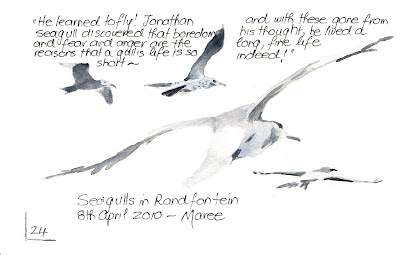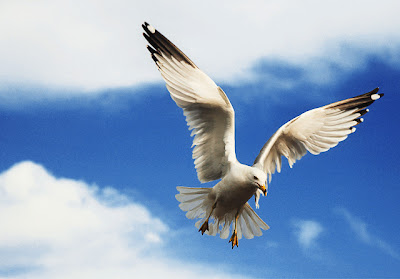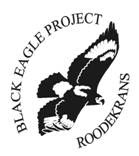Monday 26 April 2010
Peeps, the Hummingbird baby
Wednesday 14 April 2010
Thorn Trees of Africa

Thorn tree - watercolour on Ashrad 300gsm - 11" x 7.5" - Maree
Umbrella Thorn {Acacia tortilis}
There are few more striking symbols of Africa than a thorn tree - its gnarled branches, graceful form, jagged thorns and abundant blooms, in many ways reflecting the paradoxes of the continent.
This Umbrella Thorn (Acacia tortilis) stands in one corner of my garden and offers a safe haven for many birds who seek a safe place to nest.
Umbrella Thorn Acacia {Acacia tortilis}
The Umbrella Thorn Acacia grows in Africa. There are over 700 species of the Acacia in Africa. Umbrella Thorn Acacia is one of the most recognizable trees of the African savanna. It grows in sand dunes and rocky grounds of Africa's grasslands. Acacias grow in areas with annual rainfall as low as 4cm. This tree can survive in 50°C temperatures during the day, and freezing temperatures at nights. The savanna that the Acacias live in is hot and dry in the respective summer of the Southern Hemisphere although at night the temperature can go below -18°C. During the winter months the savanna gets a lot of rain. The Umbrella Thorn grows up to 20 meters high and has a spreading, flat-tapped crown that gives it its name.
The structure of umbrella thorn trees preserves soil moisture by having a high proportion above-ground woody mass and low amount of foliage and the utmost top tips are a favourite grazing spot for Giraffes.

(Info from Wikipedia)
Sunday 11 April 2010
Friday 9 April 2010
Seagulls in Randfontein
- From Jonathan Livingstone Seagull

Seagulls in Randfontein - a quick watercolour study in my Moleskine watercolour sketchbook 8" x 5.5"
Not far from us, about 22km, lies the gold mining town of Randfontein, about 45 km west of Johannesburg, South Africa. With the Witwatersrand gold rush in full swing in 1889, mining financier J.B. Robinson bought the farm Randfontein and floated the Randfontein Estates Gold Mining Company. The town was established in 1890 to serve the new mine and was administered by Krugersdorp until it became a municipality in 1929.

We visited Randfontein yesterday, and what amazes me about this town is the fact that you can find flocks of Seagulls there, 600km from the coast! I've tried to track the history of how these birds could have landed up there, but to no avail - I have now contacted the Publicity Association in Randfontein with a query, so hopefully the mystery will be solved soon!

Monday 5 April 2010
Dinner is served!

Many of us who put out food for hedgehogs would like to know more about our night-time visitors and how the food affects their lives. How far do they come to feed? How much do they eat? How important is this extra food supply? And are we discouraging them from their natural diet? The answers to some of the most commonly-asked questions are based on a survey of "garden hedgehogs" carried out by a team f biologists.
Hedgehogs don't necessarily live in the garden where they are fed. They may live nearby, or some distance away; some hedgehogs may come half a kilometer to the food bowl.
They certainly don't move their nests to get nearer to the regular food supply. It's not proven that, when they set out on a night's foraging, that they head straight for the food bowl and sometimes might not pitch up at all.
Hedgehogs are not "faithful" to one food bowl. They are likely to visit several gardens, and don't behave as if they "own" the feeding site; they don't squabble with one another when they meet there either.
the hedgehogs' appetites vary. In the survey, the most food eaten at one visit was 94g, more than one-tenth of the hedgehog's body weight. The most eaten in the course of an evening was 157g, but the average was 7g for every minute they spent at the bowl.
People are sometimes concerned that putting out artificial food will discourage hedgehogs from eating enough natural food. And how much is "enough" natural food? One thing is certain - even though hedgehogs may welcome the food we provide, they still seek out natural food even after a hearty meal at the bowl!
And what happens when the regular food supply is interrupted - when we go on holiday, for example? The hedgehogs don't seem to mind - they continue to forage for natural food in the area, as they have done all along!
Info from "Everything You Want To Know about Hedgehogs - Dilys Breese"
..
Friday 2 April 2010
Uninformed and Totally Irrational
"Deadly Spiders" at Eagle Canyon

"I had an e-mail from concerned someone who lived at Eagle Canyon, a Golf Estate in Gauteng. After receiving a hoax e-mail regarding Violin Spiders, the Estate Manager decided that to protect all the children on the estate, all spiders should be killed on sight. I was also told that there were Violin Spiders everywhere in people’s houses. Cool! I said, please collect some and bring them along to the talk.
Feelings obviously ran deep as I received a phone call instructing me not to say any good things about spiders. As you can imagine... I was not impressed. This kind of behaviour really disturbed me so I offered to give the facts about venomous spiders and scorpions.
I gave a presentation that I give to Pretoria University for their Diploma on Tropical diseases. It’s a post doctoral course and therefore my data and presentation has to be top notch, referenced and based on medical facts. I had modified it for the target audience but it contained the same facts, spider bite pictures and reference to hoax emails.
Digital projector and laptop under my arms I entered the Club House determined to present the facts, and answer any questions that they may have. The talk was well attended but I could see that it was going to be an uphill battle. The majority of the audience were so negative and misinformed. Claims of spider bite victims slipping into comas, descriptions of massive tissue damage and even numerous unnamed medical Doctors who were grateful that I was going to warn the public of the dangers these spiders cause were kicked around with idle contempt. Initially I was told that “there are Violin Spiders everywhere inside houses”, something I serious doubt in Gauteng. Someone did bring a single dreaded Violin Spider to the presentation but it was in fact a harmless Wolf Spider. So much for Violin Spiders running around everywhere.

During the presentation I gave the facts. What was interesting was the lack of understanding and appreciation from the educated audience. Most of us want to live with Nature and even pay a premium for it. The Golf Estate was no exception. However, when nature comes too close some get upset and react in an irrational way. “Kill it” is the reaction but hang on... We as humans built out homes on their homes. We have destroyed their natural habitat and provided attractants such as lights at night, water and favourable habitats. It’s no wonder that many creatures seek refuge near human habitation.
Something that that I always find to strange is that we shop at Woolworths because their food is pesticide and additive free. We pay a premium for organic vegetables and meat because of the risks associated with preservative, colour enhancing and growth stimulating chemicals that so many foods contain today. However, we are perfectly happy to spray our homes top to bottom with insecticides in order to kill insects that we encouraged to move in, in the first place. These insecticides are safe in small doses but how many of us actually adhere to the recommendations on the back of the can? These recommendations are there to make the product safe to use. Spray more than you should do and you are exposing you and your family to harmful levels of toxic chemicals.
Another issue I want to touch on in this article is the idea of unused land is waste land. Open, unused land is not wasteland. It’s not a piece of land that should be manicured, tidied up or made visually beautiful. It’s a piece of naturally occurring land that provides much needed micro habitats to a myriad of creatures and plants. It’s not a waste of space. They are islands within the urban environment where nature can thrive and seek shelter from humanity. Don’t hack and slash the grass, remove rocks to build a rockery, introducing Large Mouth Bass to natural waterways spells death for indigenous fish and amphibian populations.
Of all the preconceived ideas that had prompted me to give the presentation, not a single one was rational and factual. As I wrapped up my presentation, I felt I had added my bit of good in the world. The facts had been presented, questions answered, hoaxes expound, opinions changed. I hoped that the little good that I had done would spread to others at the Golf Estate and even further. The spiders would not be seen as deadly creatures to be persecuted on site. A little more thought would be taken, and a little more tolerance and respect would be given to Mother Nature."
Saturday 6 March 2010
Black Eagle Project Feb. 2010

What’s Happening at Roodekrans
FEBRUARY 2010
The ‘Black Eagles of Roodekrans’ have started to re-furbish their nest for the next breeding season. Large sticks and branches are being brought to the nest with Emoyeni carefully placing them where she would like them to go – this is woman’s work and Thulani is chased from the nest – his job is to supply the furnishings.
The good news is The Black Eagle Project played an intrinsic part in the prevention of a large housing development in Proteadal Ext 1. This area falls within the vital Paardekraal Ridge hunting territory of the black eagles, which is necessary for their continued survival in this area. The Gauteng Department of Environment passed a negative Record of Decision for the continuance of this development mainly because the site is located on an untransformed ridge, which is considered to be part of a wildlife corridor important to connecting biodiversity in the area
The Black Eagle Project would like to get the cam running again this year, unfortunately it is going to cost in the region of R32 000.00. We have so many queries as to why ‘live from nest’ is not on the Internet; well, the reason is we just have not got the funds to be able to convert to digital. Africam has put together a proposal on the project at hand and this can be emailed to you should you be interested in sponsoring this project. We would include your business logo or name on our web page and at the TV monitor at the Visitor’s Centre at the entrance to the Walter Sisulu National Botanical Garden. National and international supporters would then be able to watch the eagles on the nest during their breeding season – February to October.
We have still not had a ruling on the case against Sugarbush Estate, which was heard in court in November 2009. Who says the wheels of justice turn slowly! We also need funds urgently to continue with this case, as we are responsible for paying any disbursements and court costs. We have a very good chance of winning this case but need financial support from the public.
This year we would like to attach a patagial tag in conjunction with a ring to the juvenile. Blood will be taken to sex the bird and to store DNA at the blood bank for further research. For us to be able to do this we need approximately R10 000.00, this will be used to pay the researchers from Pretoria/ Wits Universities, who do the job and to purchase the tag. By doing the tagging it will be easier to identify the bird out in the field – from the sightings we are able to understand the flight patterns and it lets us know where these young eagles go after leaving the natal area.
I appeal to all our supporters please donate and help us keep the eagle safe for everyone to enjoy. They deserve to stay in the area as this is where they belong – they where here long before all the development. We understand that times are tough out there so any amount will be greatly appreciated.
Thank you for your continued support the eagles really appreciate it.
Yours in conservation
Libby Woodcock
Project Co-ordinator
Banking Details:
First National Bank
Account Number: 62108581043
Branch Code: Randridge Mall 255-955
Swift Code: FIRNZAJJXXX (International Deposits Only)
Account Name: Black Eagle Project Roodekrans Inc
Kindly use your company name or surname as a reference.
If possible email deposit slip to verreaux@mweb.co.za



